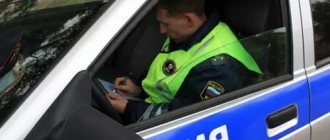What is the first step in drawing up a decision on a case or a protocol?
Despite the similarity of the documents, they are very different from each other. In particular, the difference in terms of compilation. To figure out which document is drawn up first, you need to familiarize yourself with what is hidden under the definitions.
Attention! If you have any questions, you can chat for free with a lawyer at the bottom of the screen or call Moscow; Saint Petersburg; Free call for all of Russia.
The traffic police protocol is a procedural document. Authorized officials are required to formalize it if there is an administrative offense and if any event occurs. The paper is drawn up if a traffic police inspector notices a violation of traffic rules in the actions of drivers. It must be borne in mind that drawing up a protocol does not yet confirm that the driver’s guilt has been proven.
In the process of drawing up a document, a traffic police officer may commit a gross violation. This will result in termination of further consideration of the case. The protocol acts as a starting point for the start of the proceedings. That is why it is issued first.
The traffic police decision is the result of consideration of the circumstances of the case. The specifics of its design directly depend on the seriousness of the incident. If the offense is minor, a verdict may be reached on the spot. If a gross violation of traffic rules is committed, a decision is made by the court. The paper is always drawn up after the fact of an offense has been documented.
What is a protocol?
This is a procedural document drawn up in the event of an event or an administrative offense. It is filled out by a traffic police inspector who detected a traffic violation in the driver’s actions .
The compiled protocol does not yet prove the driver's guilt . The protocol serves as the basis for issuing a decision on an administrative violation.
When drawing up a protocol, a traffic police officer may commit gross procedural violations. Drawing up a protocol is preparation for the consideration of the case.
If there is no testimony of witnesses or photo and video materials proving the driver’s innocence, when deciding on punishment they rely on the protocol. Therefore, the motorist must carefully read what information the traffic police inspector entered into the protocol .
Previously, the preparation of the protocol was regulated by paragraph 109 of the Order of the Ministry of Internal Affairs of March 2, 2009 No. 185. But this document has lost force.
According to Article 28.1 of the Code of Administrative Offenses of the Russian Federation No. 195-FZ, as amended, which came into force on 10/29/2017 (“Consultant”: https://www.consultant.ru/document/cons_doc_LAW_34661/6316f0363775130d5f77e6d9ee6584accf8a9701/): a case of an administrative offense can be considered initiated (one of the grounds) from the moment when a protocol of inspection of the scene of the offense is drawn up.
Article 28.5 of the same Code regulates the time frame for drawing up the protocol:
- immediately after detection of an offense;
- if additional clarification of the circumstances of the case or other data is necessary, the protocol must be drawn up within two days from the moment the offense was discovered;
- if an administrative investigation is carried out, a protocol is drawn up when the investigation is completed within the time limits provided for in Article 28.7 on the Administrative Investigation.
What information should be included in the protocol?
The protocol indicates the date, place of compilation, position, full name of the officer drawing up the protocol, information about the detained person, time, place, reasons for detention (Article 27.4).
Also indicated (Article 28.1.1):
- actions of officials and the order in which they were carried out;
- condition, quality of the road, presence or absence of markings, whether the section of the road on which the violation was committed was illuminated;
- the type of intersection (controlled or unregulated) at which the driver committed a violation, whether the traffic light was working, whether there were priority signs;
- other important circumstances.
In the protocol, the inspector indicates statements of persons who participated in the inspection. They are explained their rights and responsibilities under the Code. The inspector makes an appropriate entry.
The employee must also make a note about the use of photography and video recording and other methods of recording evidence. The received materials are attached to the protocol.
The protocol indicates the legal act that was violated, a detailed description of the situation, and an article providing for liability for the offense.
The document is signed by the official who compiled it and the detained driver. If the motorist refuses to sign it, it is necessary to make an appropriate entry in the protocol. A copy of the protocol must be given to the motorist (at his request).
The protocol (prosecutor's decision) is sent to the judge, body or official authorized to consider the case of an administrative offense within three days from the moment the protocol is drawn up (Article 28.8).
If the culprit faces arrest or is expelled from the country, the report is handed over to the judge immediately after drawing up.
If the protocol was drawn up by an unauthorized person, if it contains errors, if the article for the offense is not indicated, the shortcomings are eliminated within three days from the date of their receipt from the judge, body, or official who considered the case.
The case materials must be returned to the specified judge, body, or official within 24 hours from the date the errors are corrected.
All witnesses must be included in the protocol . All capable citizens can be witnesses, even close relatives, if they were eyewitnesses of the event (for example, they were passengers).
If the form has empty fields, they must be filled in by writing Z. Then unscrupulous traffic police officers will not be able to provide false information about what happened. As an explanation, it is better to indicate: “I did not violate traffic rules, I do not agree with the inspector” (provided that there were really no violations).
The following should also be noted:
- whether an accident diagram was drawn up;
- whether the rights and responsibilities were explained by the traffic police inspector;
- if the employee indicated the word “violator” everywhere, it must be corrected to “driver” (guilt has not yet been proven);
- whether the motorist's witnesses were included.
The driver has the right to petition to postpone the hearing of the case to a more convenient date. You can move the place of consideration when the driver was detained in a foreign city.
Difference of concepts
The difference between a resolution and a traffic police protocol lies in the purpose of the papers and the legal consequences that their execution has for the driver. If the inspector has drawn up a protocol on the violation, there is no need to pay a fine. The driver's guilt has not yet been proven.
During the paperwork process, a person has the right to express his opinion. If he does not agree with certain factors, he can report this to the inspector who issued the paper. If serious errors were made when drawing up a traffic police report, it will be declared invalid. This will allow the driver to avoid liability for offenses committed.
The resolution is drawn up when the consideration of the case is completed. It sets out the punishment to which the offender is subjected. The driver has the right to appeal the decision in court. If this does not happen, the person is obliged to comply with the instructions contained in the paper.
What to write in the protocol if you do not agree with a traffic violation?
One of the basic rules for filling out a protocol by a driver, in which many drivers are mistaken, is that they harm themselves if they refuse to sign the document. As we said above, you don’t need to do this, but, on the contrary, carefully study it and sign it, as well as make the necessary notes, but which ones?
So, if you do not agree with the traffic violation charged to you, then you need to write the following in the protocol. It is important to write briefly and concisely. But, if your text does not fit in any columns, then write in these corresponding columns: “I gave the explanations on a separate sheet” and, of course, write what you want on a separate paper.
- In the field for explanations of the person involved, you need to write: “I do not agree with the violation. I need the help of a defender." Thus, you immediately report the fact of challenging a traffic violation. If you do not write this right away, then this, of course, will not deprive you of the right to appeal the decision with a fine, but the judge or other body considering the case will take into account that you did not agree with this initially. You can also briefly write a rationale for disagreeing with the violation.
- In the same column, if the traffic police officer did not explain your rights, you also need to make a note about this: “Rights not explained.”
- If there are witnesses or there is a video recording that can prove your innocence, write in the comments: “There is a video recording from the recorder.” or “There are witnesses [full name]. I request their involvement in the consideration of the administrative case.”
- If a traffic violation was committed (or not committed, but the traffic police officer blames it) in another city, and you want the case to be considered in your city, then write in the comments: “I am requesting that the case be considered at the place of residence.” The inspector must grant this request or provide compelling reasons for refusing to grant it. It is important to know that employees also respond to written requests in writing.
Resolution or protocol on an administrative offense
If a minor offense has been committed, a verdict in the case may be reached on the spot. However, the driver has the right to demand that the inspector only document what happened by drawing up a report, and make a verdict in court.
Experts advise insisting on your own if there are controversial issues in the case. Proceedings in court will help you defend your case. A citizen cannot refuse to record a committed offense. The decision on the need for paperwork is made by the traffic police officer.
General information about protocols
Diligent inspector filling out papers
The preparation of the administrative protocol of the traffic police is carried out taking into account certain rules and requirements. This document must include the following information:
- date and place of document preparation;
- Full name and position of the person drawing up the protocol;
- information about the offender;
- Full name and registration of victims and witnesses;
- time and place of the violation committed;
- an article from the legislation according to which the driver is planned to be punished;
- explanations of witnesses or eyewitnesses;
- additional important details.
Motorists against whom a protocol is being drawn up must be given a detailed list of their rights and obligations when filling out the document. This is also logged. The inspector must familiarize the violator with the protocol, and the list of rights provides for the possibility of writing an explanation and making additions to the protocol. A copy of the document is given to the person who is subject to the paperwork. Also, a copy remains with the injured party, if any.
Deadline for issuing a decision
The protocol is the main evidence of the driver’s guilt. It is issued at the scene of the incident. There are exceptions to the rule. If there are controversial issues or details need to be clarified, the period for processing the document can be extended to two days. This is not considered a violation.
The resolution is drawn up after the proceedings on the administrative offense have been completed. If we are talking about a fine, the verdict is rendered within 2 months. In the case of a serious offence, the period may be extended to 3 months. If a decision is not made within this period, the case is closed.
The verdict in the case comes into force within 10 days from the date of its adoption. According to current legislation, the document is valid for 2 months. During this period, you must pay a fine to the traffic police. If a citizen has not complied with the order, enforcement proceedings may be initiated against him.
Witnesses
Make sure that the inspector enters into the protocol the information of witnesses, for example, our passengers. If the traffic police officer refuses to do this. referring to that. that your passengers are interested parties, enter the witnesses into the protocol yourself, since interest is not a basis for disqualifying a witness. In the explanation column, note that the inspector refused to include witnesses in the protocol. If you are alone in the car and there are no witnesses, put Z in the appropriate column so that later you do not meet unexpected eyewitnesses at trial. We advise you to put Z in all empty columns.
Rule of law
“A person who may be aware of the circumstances of the case that must be established may be called as a witness in a case of an administrative offense. The witness is obliged to appear when summoned by the judge, body, or official who is prosecuting the case of an administrative offense, and to give truthful testimony: to report everything known to him about the case, to answer the questions posed and to certify with his signature in the appropriate protocol the correctness of recording his testimony" ( Parts 1-2 of Article 25.6 of the Administrative Code).
You are in a foreign city or on a long trip
When drawing up a protocol, you can request that the case be considered at the place of registration of the car or at your place of residence - for this purpose, special request forms are used, which are best taken with you. The consideration of the case at the place of registration of the car and at the place of residence of the driver has differences; we will tell you more about them a little later.
When is a traffic police resolution drawn up without a protocol?
In practice, there are several cases in which a traffic police decision on a case can be issued without a protocol. This is possible in the following situations:
- The offense was recorded on photo or video cameras. Information about the need to pay a fine is sent by mail.
- If a citizen agrees with the violation that the traffic police inspector imposed on him.
- If an administrative penalty was imposed in the form of a warning or a fine at the scene of the offense. Only an authorized person has the right to perform such an action.
- The citizen does not dispute the existence of an offense.
A complete list of situations for drawing up a traffic police resolution without a protocol is enshrined in Article No. 28.6 of the Code of Administrative Offenses of the Russian Federation. A copy of the documented decision is provided against signature to the person in respect of whom it was made. If the person refuses to receive it, the paper is sent by mail. The action is carried out within 3 days from the date of the decision on the case.
Resolution
So how does the protocol differ from the traffic police resolution? The resolution is the result of consideration of the administrative protocol.
If the inspector has drawn up and signed a protocol and the driver’s guilt has not yet been proven, the motorist has the right to disagree with some of the information in the protocol. If it contains serious errors, the document may be considered invalid, and liability can sometimes be avoided.
The resolution is the final result of the consideration of the case. It is executed or appealed in court.
A traffic police fine order is a document issued by a traffic police inspector with or without a violator. The decree obliges to transfer the assigned amount within a certain period.
If the inspector issued a resolution without a protocol, you need to remember when the resolution can really be drawn up like this:
- if punishment in the form of a warning or an administrative fine is imposed at the place where the administrative offense was committed (Article 28.6 of the Code of Administrative Offenses of the Russian Federation), and the driver agrees with his guilt;
- The violation was recorded by security cameras that operate automatically.
A copy of the resolution is given to the culprit and the victim (at his request). If the culprit refused to receive a copy of the decision, it will be sent to his address by registered mail within three days from the date of the decision.
If a motorist violates several traffic rules at once, only one decision is issued. The document contains information about all offenses committed.
The form of the resolution can be paper or electronic . Decisions are made electronically after violations recorded by cameras. A copy of the document is sent on paper.
What information is included in the resolution?
Article 29.10 regulates that the resolution must indicate the following information:
- position, full name of the judge, official, name of the body that made the decision, their legal address;
- date, place of consideration of the case;
- information about the person against whom the case was considered;
- established circumstances;
- articles that provide for administrative liability for committing an offense;
- decision on the case;
- deadline, procedure for appeal.
A copy of the resolution with the attachment of materials that were obtained using technical means operating in automatic mode and having photo and video recording functions is sent to the offender on paper.
It is necessary to pay attention to the date of the decision. The date affects the period within which it will be possible to appeal the imposed sentence. There is a ten-day period for appeal. Also, the period for payment of the fine is calculated from the date of the decision.
What is being appealed, the ruling or the protocol?
Appeal
The protocol contains information about what happened. After reviewing the protocol, a decision is made on the punishment. The decision is indicated in the resolution, and it can be appealed.
The procedure for filing a complaint is regulated by Article 30.2 of the Code:
- The application is sent to the judge, body or official who made the decision. They must, within three days from the date of receipt of the document, send it with the relevant materials to the appropriate court, higher authority, or higher official.
- There is no need to pay a state fee for a complaint.
- Submitted within ten days from the date of receipt of a copy of the document.
- If the deadline is missed, and the motorist has good reasons (and they can be proven documented), the deadline can be restored.
- The complaint is considered within 10 days from the day it is received with all materials by the relevant authority. Or within two months if the case went to court. And also within 24 hours if the person brought to administrative responsibility is under administrative arrest or is subject to deportation from the country.
The applicant must complete the application correctly . It must contain information about the applicant: passport, address, information about the car, a detailed description of the circumstances of the incident.
The application must be accompanied by the necessary materials for the case (data from the video recorder, photographs from the scene of the incident). It is important to include in the document articles of law that confirm the absence of an offense and testimony of witnesses.
The motorist submits a complaint in person, or by registered mail with notification or through the official website of the organization.
Resolution number
There are often cases when the driver does not receive a decision, but knows that he has been issued.
To make a payment, it is not necessary to know the order number. All you need to know is your driver's license number.
But sometimes you may need an answer to the question of how to find out the protocol number by the resolution number.
It is not difficult to find by the order number the amount to be paid, as well as for what violation the fine was imposed.
The mobile application “Traffic Police Fines”, in which you can find out about the fine by the number of the resolution; the data is provided, but it is scanty. How to see the traffic police fine report by resolution number?
You can use the Autocode portal: https://avtokod.mos.ru/.
There you can also see photographs of the violation. The portal contains photographs of the following types:
- photo of a car with license plates;
- panoramic photographs of the area;
- with the trajectory of the car.
You can also find out information about the violation - date, time, date and number of the decision on the violation, the amount to be paid and other data. The portal allows you to automatically issue a receipt for payment.
A ruling is practically a recognition of a motorist as guilty of violating traffic rules . While the protocol only reflects information about what happened. It does not prove the driver's guilt.
But some traffic police officers, who take advantage of the legal ignorance of drivers, issue a decision without reason, and the motorist is left to pay a fine or appeal the decision.
What does the traffic police inspector write out, a protocol or a resolution? Both documents. A resolution is issued (or sent to the violator’s address) if the violation was recorded by cameras. Or the motorist admits his guilt in the violation.
If the driver faces deprivation of his license, a decision is not issued, a corresponding protocol is drawn up!
Let us remind you that the protocol is a recording of a violation. The ruling is the punishment imposed. When a protocol is drawn up, the driver has a greater chance of avoiding punishment than after a decision is drawn up.
Video: DPS UFA. LikBez No. 3. "Protocol vs Resolution"
Sample protocol and sample resolution
In order for a protocol on an administrative offense to be recognized as valid, it must contain the information established by current legislation. The list of data that must be entered in the document is recorded in Federal Law No. 195. The list of mandatory information that must be present on the paper includes:
- date and place of registration;
- position and full name of the traffic police officer;
- information about the citizen who violated the established rules;
- date of commission of the offense and place of incident;
- norms and rights that require accountability for an action committed;
- other facts that will be useful during the proceedings.
The traffic police resolution must also comply with established standards. It reflects the following data:
- date and place of consideration of the case;
- information about the person who made the final verdict in the case;
- information about the citizen in respect of whom the document was issued;
- circumstances that were established as a result of the consideration of the case;
- reasoned decision on the proceedings;
- signatures of the participants in the proceedings.
The absence of mandatory information may result in the decision on violation of traffic rules being invalidated.
Sample traffic police report 2021
The legislation of 2021 regulates only the procedure for filling out the protocol regarding the mandatory data that must be indicated in it. There is no sample protocol in the established form. But there is a recommended sample, which is prescribed in the Administrative Regulations of Order No. 664 of the Ministry of Internal Affairs.
The protocol is filled out on both sides and has one sheet.
Sample of the front side of the protocol:
Reverse side of the protocol:
.
Time between documents
The resolution is drawn up after the protocol. The period for taking action directly depends on the duration of the proceedings. Usually the effect takes place within 2-3 months. The exact period depends on the seriousness of the offense. So, if a citizen is issued a fine, it must be paid within 2 months.
If they want to confiscate a driver’s driving license or apply another, more severe punishment, the duration of the proceedings can be 3 months. If the final verdict has not been rendered, the proceedings are terminated. In this situation, a citizen can avoid punishment.
Results
We bring to your attention a video that details the differences between a protocol and a resolution:
To summarize all of the above:
- Although both documents are drawn up when violations are detected by the driver on the road, the resolution is already a recognition of you as having committed a violation, and the protocol is a kind of preparatory stage for the consideration of your violation and the proceedings on it.
- A decree can be issued without witnesses; drawing up a protocol requires the mandatory presence of witnesses to the incident.
- A protocol is drawn up during serious offenses, for which the driver can be brought not only to administrative, but also to criminal liability if people died as a result of his actions. Road citations are issued for less serious administrative offenses with a fine or a warning.
- The protocol in the future usually implies a more severe punishment if your guilt for the offense is proven, ranging from a fine or deprivation of the right to drive a vehicle up to criminal liability if people were injured. The resolution only implies a fine.
- Both documents can be challenged if there is strong evidence of innocence.
You can read other relevant articles on our website; we talk about everything that may interest our reader.
Good afternoon, dear reader.
A protocol on an administrative offense is a procedural document that can be drawn up by a traffic police officer when a violation of traffic rules is detected.
142. The grounds for drawing up a protocol on an administrative offense are:
- identification of an administrative offense if the consideration of a case regarding this administrative offense is not within the competence of the employee;
- challenge by a person against whom, in accordance with Part 1 of Article 28.6 of the Code, a case of an administrative offense has been initiated, the existence of an event of an administrative offense and (or) an administrative punishment imposed on him or refusal of the corresponding signature in the resolution on the case of an administrative offense;
- identification of an administrative offense committed by a minor who has reached the age of sixteen;
- identification of an administrative offense that does not entail a warning, committed by a sergeant, sergeant major, soldier, sailor undergoing military service on conscription, or a cadet of a military educational institution of vocational education before concluding a contract with him for military service.
The protocol must be drawn up in the following cases:
1. If the case of violation of traffic rules cannot be examined by a police officer. For example, cases of violations involving , are considered only by judges. Accordingly, they require the mandatory preparation of a protocol.
2. The driver disagrees with the violation. This is another popular situation. If the driver does not agree with the inspector, then instead of the decision (or together with it) a protocol is drawn up.
An important difference between the protocol and the presence of the field “explanation of the person against whom the case has been initiated.” In the protocol you can indicate your own vision of the situation. In this case, you need to use links to paragraphs of traffic rules and other regulatory legal documents.
Since the final decision to impose punishment will be made on the basis of the protocol, you must carefully fill out the “explanation of the person” field.
3. Violation of traffic rules by minors. This is possible, for example, when driving vehicles M or subcategory A1.
4. If the violation was committed by a sergeant, sergeant major, soldier, sailor, cadet.
Protocol and resolution in one day
Cases when the traffic police protocol and resolution are drawn up on the same day are known in practice. This does not contradict current legislation. The approval is valid only if the decision is made by persons with appropriate authority in compliance with all existing procedural requirements.
However, such decisions can be appealed. A citizen has the right to appeal to a higher authority. The detailed rule is enshrined in Article No. 30.1 of the Code of Administrative Offenses of the Russian Federation. A complaint may be filed within 10 days. If an administrative investigation is required, the period is extended.
What to pay attention to when reading the protocol of a traffic police officer
What to pay attention to when reading the protocol of a traffic police officer
Some drivers do not know what to pay attention to when reading the protocol drawn up by the traffic police officer. Meanwhile, competently familiarizing yourself with the protocol and adding your objections to it is an important point that affects the likelihood of further appealing the actions of the traffic police officer.
What should a driver pay attention to when reading the protocol?
You need to get acquainted with the protocol according to certain rules. First, the motorist checks that the column “date, time and place of compilation” of the protocol is filled out correctly in the protocol. Why is it very important that these fields are filled out correctly (not just filled out, but filled out correctly).
The fact is that the time frame for drawing up protocols should be minimal; protocols should be filled out in strictly defined places (for example, in the place where a violation was discovered and immediately after the grounds for drawing up protocols arise).
An inspector who has committed violations regarding the procedure for drawing up protocols may not fill out a certain column of the protocol or fill it out incorrectly. If the protocol column is not filled in, the driver will not pay attention to the violation and will sign the protocol. If the traffic police officer does not give the driver a copy of the protocol and fills out this column later, it will turn out that the driver has certified with his signature that the protocol contains reliable circumstances. Then it will be difficult for the motorist to prove the violation committed by the traffic police officer precisely because he did not pay attention to this point when reading the protocol.
For this reason, you must immediately ensure that all columns of the protocol are filled out correctly and be sure to receive a copy of the completed protocol. If there are blank fields in the protocol, then you need to point this out to the inspector and ask him to put a dash there. And you only need to sign for a copy after it has actually been handed to you.
Also in the administrative violation protocol there is a column indicating whether the motorist speaks Russian or does not speak it. If a motorist does not speak Russian sufficiently to competently protect his rights, then you need to check that in this column “speaks/does not speak” a mark is made that the driver does not speak Russian.
An important point when reading the protocol is also for the driver to check the column “actually residing at the address.” The fact is that the address where the driver lives may be indicated in this column incorrectly. For example, the inspector will not indicate the driver’s residence address, but his registration address. In addition, the traffic police officer may completely confuse and indicate the wrong address of the driver’s house or apartment.
If a motorist does not check that the column “actually residing at the address” is filled out correctly and confirms the incorrect data with his signature, then he will be in trouble. The worst thing that can happen for the driver in this case is that the case will be considered without his participation (the summons, of course, will be sent to the address indicated in the protocol, but the address is incorrect).
Other problems are possible if the motorist does not check the information entered in this column. For example, due to incorrect information, the driver will subsequently not be able to transfer the case to his place of actual residence. In the refusal to satisfy the driver’s request, there will be a reference to the fact that he initially indicated a different address (the court will think that the driver is “cheating” something).
Checking the “works/doesn’t work” column is also an important point for the driver. In some cases, the traffic police inspector automatically writes “not working” in this column. Such a record is not always beneficial to the motorist (they may induce the driver to indicate himself as unemployed with reference to the fact that when the case is considered in court, it will allegedly inform his work that this motorist is violating traffic rules).
For example, if a traffic police officer accused a driver of violating traffic rules that requires arrest, then indicating oneself as unemployed may lead to the imposition of a punishment in the form of arrest, rather than a fine (which may be provided for this violation). After all, an unemployed person will not be able to pay the fine, which means he needs to be arrested.
When reading the protocol, you must pay attention to the column “date, time and place of the administrative offense” and the column “substance of the violation.”
For example, a driver is charged with driving into oncoming traffic in violation of traffic rules (violating a sign or marking). It is clear that in this case it is very important to clarify the specific place where the violation was allegedly committed. Maybe this place does not or should not contain a continuous marking line, a road sign (on paper or in reality).
You need to check everything, right down to the number of the house in the area that the inspector believes has been violated. The correct indication of the house number to which the traffic police officer “links” your protocol is also a very important point. It is no secret that by default a case of an administrative offense is considered at the place where the alleged violation was committed.
If the inspector incorrectly indicates the house number, then the case may be considered by the wrong judge to whose jurisdiction it is assigned by law (for example, one house number is judicial precinct No. 1, and another house is already judicial precinct No. 2).
The “substance of violation” column is another important point. After all, based on what exactly the driver allegedly violated, he will give his explanations. It still happens that motorists are given written explanations without even understanding what exactly they are accused of. This situation can be encountered especially often when a traffic police officer simultaneously draws up two protocols or a protocol and a resolution. In this case, the driver writes in the protocol explanations that relate to a completely different matter. Such confusion is detrimental to the car enthusiast.
To avoid this, he must carefully read and understand for himself the content of the “substance of the violation” column. After this, he will be able to give competent written explanations on the merits of the case.
Next in the protocol there is a column in which it is written under which part and article of the Code of the Russian Federation on Administrative Offenses they are trying to attract the driver. The information contained in this column is important for a car enthusiast, since by opening the Code of Administrative Offenses of the Russian Federation on the page with this article, he will be able to understand what kind of punishment he faces: a fine, arrest, deprivation of a driver’s license, compulsory labor.
Below is the column “information about witnesses and victims.” If the driver has witnesses, then he must draw the attention of the traffic police inspector to the need to fill out this column by entering their data into it. If the traffic police officer refuses to do this, the driver will be able to enter the data of witnesses in his written explanations (the corresponding column in the protocol is located below). In any case, then in the column “information about witnesses and victims” there should be a dash.
If any witnesses are indicated in the column, then you need to check with the inspector who these people are. The driver has the right to make a request to interview witnesses, has the right to ask questions to these people, etc. Witnesses must be explained their rights and responsibilities, and they must be warned about the liability for giving false testimony.
Next comes a column about explaining to the motorist his rights. When drawing up a protocol on an administrative offense, a traffic police officer is obliged to explain to the motorist his rights. If the inspector did not do this, then you need to make a note about this in the protocol or require the traffic police officer to fulfill his duties.
The law states that rights must be “clarified.” If a motorist does not understand something after reading Article 25.1 of the Code of Administrative Offenses and Article 51 of the Constitution of the Russian Federation, then he can demand from the inspector an explanation of these articles and the rights listed in them.
Next comes the column “attached to the protocol.” This column should indicate a list of evidence collected by the traffic police officer in this case. For example, such and such a protocol, a report, an explanation of a witness, etc. As you know, the driver has the right to familiarize himself with all the materials of the case. Therefore, you must definitely pay attention to this column. If necessary, you must submit a request to the traffic police inspector to familiarize yourself with the evidence listed as an appendix in the column “attached to the protocol.”
After this comes the column “place and time of consideration of the case...”. This column is also important to read. If necessary, the driver has the right to file a motion to transfer the case to his place of residence. The corresponding column is available below in the same protocol. In this case (when transferring the case to your place of residence), you need to write where exactly the driver asks to transfer the case (for example, to the court of such and such a district) and put your signature in this column.
Also in the protocol on an administrative offense there is a column “explanations of LVOC”. This column is intended so that the driver can explain what exactly happened, evaluate the actions of the traffic police officer, enter the information of his witnesses, etc.
When writing explanations, you need to pay attention to the following: the driver is not obliged to give explanations, but has the right to do so; no one should stop the motorist from writing explanations; in your explanations you need to try to reflect all important circumstances in a concentrated form; if this column is not enough, then you can ask the traffic police officer for a separate explanation form.
Below is the column “I agree to be notified via SMS message.” Agreeing to an SMS notification about the date of consideration of the case is a driver’s right, not an obligation. The driver is not required to provide his phone number at all when drawing up reports.
If the motorist has given his consent to the SMS notification, then such a notification will be considered a proper notification of the date of consideration of the case of an administrative offense (if it was not only sent, but also received in advance, for which there is evidence).
Next comes the column “explanations and comments on the protocol”; here you also need to do so if the motorist does not agree with the violation, since the contents of the protocol contain unreliable information (after all, it says that the driver committed a violation). In general, this column can be used as an addition to the column “explanations of LVOC”. Thus, you can write more information about violations committed by the traffic police officer, evidence of innocence available to the driver, etc.
Next comes the column “signature of LVOC” where the driver signs for familiarization with the protocol. Again, whether to sign in this column or not to sign is a decision made by the car enthusiast himself. If the driver was given the opportunity to enter all the necessary objections into the protocol, then he can put his signature in this column.
Below is the column “received a copy of the protocol.” This column can be signed only after a copy is already in hand. An acceptable option is also the situation when the traffic police officer gives the driver the original protocol, the driver signs in the column “received a copy of the protocol” and then tears off a copy and takes it for himself. In the above cases, the driver does not risk being left without a copy of the protocol.
In other cases, putting a signature in the “received a copy of the protocol” column before the moment when it was actually delivered may lead to it not being given. This already depends on the integrity of a particular traffic police officer.
Resolution to cancel the protocol
The protocol drawn up by the traffic police officer may be cancelled. To carry out an action, the grounds enshrined in the Code of Administrative Offenses of the Russian Federation must be present. The court will agree to grant the request for cancellation in the following situations:
- required information is missing;
- during the preparation, violations of the norms of the Code of Administrative Offenses of the Russian Federation were committed;
- the official did not explain to the participants in the incident their rights and obligations;
- the statute of limitations for considering an administrative offense case has expired;
- other violations of the provisions of the current legislation were identified.
A resolution is drawn up to cancel. A similar rule is enshrined in paragraph 1 of Article No. 28.9 of the Code of Administrative Offenses of the Russian Federation.
What it is
- The traffic police protocol is a procedural document, the content of which describes specific events that violate traffic rules.
- Resolution is a document reflecting the result of the consideration of the case, the reason for which was the protocol.
Features of the protocol:
- compiled exclusively on a special strict reporting form;
- to be filled out (other methods are not allowed): 1. with a ballpoint pen; 2. printing device;
- For each offense, its own protocol is drawn up;
- completed in the shortest possible time.
If the resolution does not specify a protocol
The list of information that must be present in the traffic police resolution is enshrined in article No. 29.10 of the Code of Administrative Offenses of the Russian Federation. According to the regulatory legal act, the document must necessarily reflect:
- information about the persons who made the decision in the case;
- place of consideration of the case and date of the procedure;
- information about the citizen against whom the punishment is applied;
- circumstances that were discovered during the consideration of the case
- a regulatory legal act that provides for liability for the offense committed;
- final verdict on the case;
- deadline and procedure for appealing a fine.
The set of additional information in the traffic police resolution depends on the individual nuances of the current situation. If the data is not required to reflect the resolution in accordance with Article No. 29.10 of the Code of Administrative Offenses of the Russian Federation, they do not need to be recorded in the document.
Sample
The document records in detail the features of what happened and looks like this:
- Title of the document;
- date, time of data recording;
- information about the traffic police inspector (full name, position);
- information about the potential offender;
- reasons for detention;
- information about the offense that occurred, its nature and detailed description;
- information about witnesses, witnesses, victims;
- the time at which the incident occurred;
- an indication of the article that was violated;
- special opinion of the person in respect of whom the protocol was drawn up (if you do not agree with the inspector’s arguments on what is stated on paper);
- diagrams and sketches of road accidents;
- information about damage to vehicles;
- additional information: 1. about the condition of the road surface (lighting, markings); 2. type of intersection (presence or absence of a traffic light regulating traffic and its serviceability, presence of road signs determining priority); 3. the procedure for performing actions by an official; 4. a record explaining the rights and obligations of the participants in the incident.
An example document is presented here.
We issued a protocol and a resolution, what should we do?
If the driver violated the traffic rules, and this fact was documented in accordance with the established rules, you must carefully read the decision made. If you agree with the verdict, the person must pay the fine or comply with other instructions contained in the document.
If a person does not agree with the decision made, he can appeal the traffic police fine. To do this, you need to contact a higher judicial authority. You must appeal the decision with reasons. The citizen must provide evidence of his innocence. If they are absent, the likelihood of the punishment being canceled is minimal.
If a citizen plans to appeal the inspector’s decision, the established deadlines must be observed. You must contact a higher judicial authority within 10 days from the date of receipt of the document. If the deadline is missed without a valid reason, you will not be able to appeal the decision.
Having decided to comply with the order, the driver is obliged to comply with the established deadlines. The fine must be repaid within 2 months from the date the document enters into force. If the period is violated, bailiffs will be involved in the case. They will enforce the collection of the traffic police fine.
Common Terminology
Filling out the protocol
First, let’s find out what a protocol is and what other terminology car owners in the Russian Federation should understand. A protocol is a description of certain events and a statement of facts regarded as an administrative offense. In the future, it will be used to prove the driver’s guilt. A protocol is drawn up in the event that it is impossible to make an exact decision on the driver’s guilt on the spot or for other reasons:
- The official does not have the appropriate powers (serious offenses are taking place).
- The driver does not admit guilt and does not agree with the punishment that the traffic police officer imposes on him on the road.
- The offender is a minor.
- A number of other cases provided for by the law of the Russian Federation.
Initially, the fact that the inspector drew up a protocol indicates that the offender’s guilt must first be proven, that is, a decision on a specific situation will not be made immediately, but later.
When the report on the violation case is reviewed by the management of the traffic police, they may issue a resolution . It will conclude whether the driver is guilty and whether he should bear the appropriate administrative penalty in the form of a fine.
When the driver has committed a minor violation or it is completely obvious, and he himself does not deny it, the inspector can immediately make a decision at the scene of the incident, issuing a receipt for payment of the fine.
How to find a resolution according to the protocol?
Today it will not be possible to find information about the resolution if only the protocol is known. All existing online systems allow you to search for data only on the first document. However, a citizen will still be able to find out the information of interest. To do this, you need to use the traffic police service, which allows you to look for fines. To carry out the manipulation, you will need to perform the following steps:
- Visit the official website of the traffic police.
- Open the service, and then click on the item “check traffic police fines”. A window will open in front of the citizen that needs to be filled out. It is necessary to enter information about the car number and information about its registration. The data can be found by examining the vehicle's title.
- Click on the “request verification” button. If all actions are performed correctly, the system will display a table showing information about unpaid fines. One of the columns contains information about the resolution number.
Additionally, a citizen will be able to find out in accordance with what provision of the law he is being punished, as well as find out the amount of the penalty.
What to do and what not to do during and after drawing up a protocol
- If you are invited into a traffic police car, refuse the offer.
- The document must be drawn up only in your presence.
- Check the accuracy of filling out all the data - whether the name of the responsible person is indicated, the date, whether witnesses and their addresses are indicated.
- Is there a reference in the document to the legal law that your actions on the road fall under?
- You may be distracted by various questions to lose your vigilance - do not react to them, do not succumb to provocation, which can lead to distortion of the actual facts in the protocol.
- If you have a recorder or camera with you, take pictures and refer to them when writing an explanatory note. If you have a modern smartphone with you, you can take a photo and record all conversations with the inspector. All this will help in appealing the protocol or unauthorized actions of the responsible person.
- If you were given an incomplete document for review, will there be other entries? If not, then ask to cross out all the extra lines.
- Check all points of the document; if another responsible person in the pair is indicated as a witness to the violation, then be sure to ask to present an ID and enter its data into the protocol.
- If there is no record of your support side, that is, the passengers who were with you at the time of the stop, state your request to enter data about them as well.
- If the record contains imaginary witnesses, ask them to be presented to you, and if this is not possible, ask them to be removed.
- If you are denied your legal demands, feel free to call the Ministry of Internal Affairs hotline at tel. 02, this can sober up the inspector.
Please know that all noticed inaccuracies in the protocol may become a decisive moment for challenging the actions of the inspector.
You can get prompt online assistance from this page from our qualified lawyers.
You can learn about how the protocol can be done from the following publication on the pages of our website.
We invite you to watch a detailed video that tells how a driver should behave when drawing up a protocol:
Appeal against the decision
A decision on an administrative violation, unlike a protocol, can be appealed. The mechanism and nuances of this process are spelled out in Art. 30.1 Code of Administrative Offenses of the Russian Federation.
The main thing you need to know is that the time limit for challenging the guilt charged to you is 10 days after the decision is made.
When a violation was recorded by special cameras, the countdown of days for appealing the decision begins from the moment you receive the letter.
To appeal a court decision, you must have a provable reason for canceling the punishment. This may be an error in the completed form (full name, date and other important information) or a complete absence of the data required for the decision.
You need to file a complaint with the magistrate or the traffic police.
In the text you indicate:
- your personal data: full name, address;
- information about the recipient: name of the body, full name and position of the addressee;
- Full name and position of the person who made the decision;
- detailed information on the case.
If information about the sender and the substance of the complaint is incomplete or unreadable, the addressee will not be obliged to respond to you.
Copies of the decision and documents on the basis of which you want to review the results of the case are attached to the complaint.










